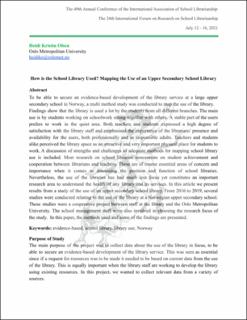How is the School Library Used? Mapping the Use of an Upper Secondary School Library
Peer reviewed, Journal article
Published version
Permanent lenke
https://hdl.handle.net/11250/2985116Utgivelsesdato
2021-09-24Metadata
Vis full innførselSamlinger
Originalversjon
https://doi.org/10.29173/iasl8287Sammendrag
To be able to secure an evidence-based development of the library service at a large upper secondary school in Norway, a multi method study was conducted to map the use of the library. Findings show that the library is used a lot by the students from all different branches. The main use is by students working on schoolwork sitting together with others. A stable part of the users prefers to work in the quiet area. Both teachers and students expressed a high degree of satisfaction with the library staff and emphasised the importance of the librarians' presence and availability for the users, both professionally and as responsible adults. Teachers and students alike perceived the library space as an attractive and very important physical place for students to work. A discussion of strengths and challenges of adequate methods for mapping school library use is included. Most research on school libraries concentrate on student achievement and cooperation between librarians and teachers. These are of course essential areas of concern and importance when it comes to discussing the position and function of school libraries. Nevertheless, the use of the libraries has had much less focus yet constitutes an important research area to understand the health of any library and its services. In this article we present results from a study of the use of an upper secondary school library. From 2016 to 2019, several studies were conducted relating to the use of the library at a Norwegian upper secondary school. These studies were a cooperative project between staff at the library and the Oslo Metropolitan University. The school management staff were also involved in choosing the research focus of the study. In this paper, the methods used and some of the findings are presented.

